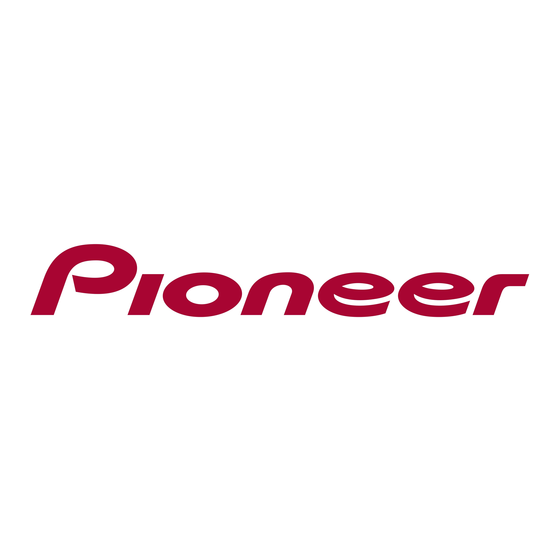Pioneer Super Tuner III D+ DEH-P7750MP Manual de instalación
Navegue en línea o descargue pdf Manual de instalación para Reproductor de CD Pioneer Super Tuner III D+ DEH-P7750MP. Pioneer Super Tuner III D+ DEH-P7750MP 6 páginas. Multi-cd control high power cd/mp3/wma player with fm/am tuner
También para Pioneer Super Tuner III D+ DEH-P7750MP: Manual de servicio (21 páginas), Manual de servicio (20 páginas)

DEH-P7750MP
This product conforms to new cord colors.
Los colores de los cables de este producto se
conforman con un nuevo código de colores.
As cores dos fios deste produto seguem um novo
padrão de cores.
Æ...b¹b'« „öÝô« Ê«
uë lÄ "UN'« «c¼ r− M¹
Printed in Thailand
<XRD7061-A/N> ES
<KSNNX> <04I00000>
60°
5
Fig. 1
Fig. 3
± qJAë
≥ qJAë
1
6
2
1
182
53
3
4
Fig. 2
Fig. 4
≤ qJAë
¥ qJAë
2
7
Fig. 5
µ qJAë
5
3
8
Fig. 6
∂ qJAë
4
6
Installation
Note:
•
Before making a final installation of the unit,
temporarily connect the wiring to confirm that the
connections are correct and the system works
properly.
9
•
Use only the parts included with the unit to ensure
proper installation. The use of unauthorized parts
can cause malfunctions.
•
Consult with your nearest dealer if installation
11
requires the drilling of holes or other modifica-
tions of the vehicle.
•
Install the unit where it does not get in the driver's
way and cannot injure the passenger if there is a
sudden stop, like an emergency stop.
•
The semiconductor laser will be damaged if it
overheats, so don't install the unit anywhere hot
10
— for instance, near a heater outlet.
•
If installation angle exceeds 60° from horizontal,
the unit might not give its optimum performance.
(Fig. 1)
•
When installing, to ensure proper heat dispersal
Fig. 7
when using this unit, make sure you leave ample
space behind the rear panel and wrap any loose
∑ qJAë
7
cables so they are not blocking the vents
DIN Front/Rear-mount
This unit can be properly installed either from
"Front" (conventional DIN Front-mount) or
"Rear" (DIN Rear-mount installation, utilizing
threaded screw holes at the sides of unit chassis).
For details, refer to the following illustrated
installation methods.
DIN Front-mount
Installation with the rubber bush (Fig. 2)
1. Dashboard
2. Holder
After inserting the holder into the dashboard, then
select the appropriate tabs according to the
thickness of the dashboard material and bend
them.
(Install as firmly as possible using the top and
bottom tabs. To secure, bend the tabs 90 degrees.)
3. Rubber bush
4. Screw
<ENGLISH>
Removing the unit (Fig. 3) (Fig. 4)
5. Frame
To remove the frame, extend top and bottom of
the frame outwards in order to unlock it. (When
reattaching the frame, point the side with a groove
downwards and attach it.)
• It becomes easy to remove the frame if the
front panel is released
6. Insert the supplied extraction keys into the unit, as
shown in the figure, until they click into place.
Keeping the keys pressed against the sides of the
unit, pull the unit out.
DIN Rear-mount
Installation using the screw holes on
the side of the unit (Fig. 5) (Fig. 6) (Fig. 7)
1. Remove the frame.
7. Frame
To remove the frame, extend top and bottom of
the frame outwards in order to unlock it. (When
reattaching the frame, point the side with a groove
downwards and attach it.)
• It becomes easy to remove the frame if the
front panel is released.
2. Fastening the unit to the factory
radio mounting bracket.
8. Select a position where the screw holes of the
bracket and the screw holes of the head unit
become aligned (are fitted), and tighten the
screws at 2 places on each side. Use either truss
screws (5 × 8 mm) or flush surface screws
(5 × 9 mm), depending on the shape of the screw
holes in the bracket.
9. Screw
10. Factory radio mounting bracket
11. Dashboard or Console
